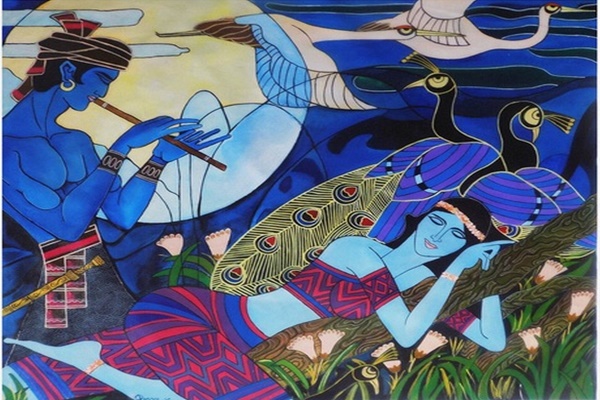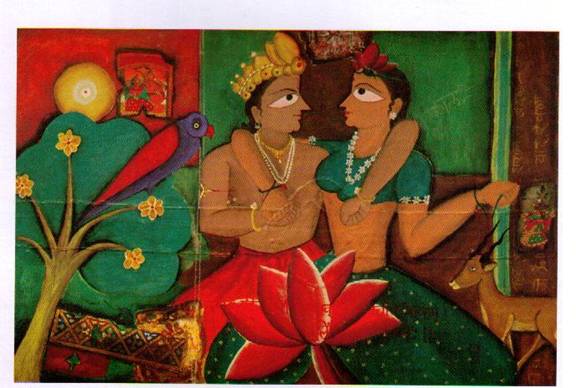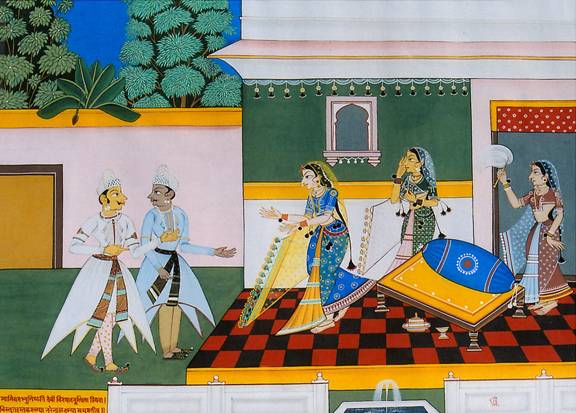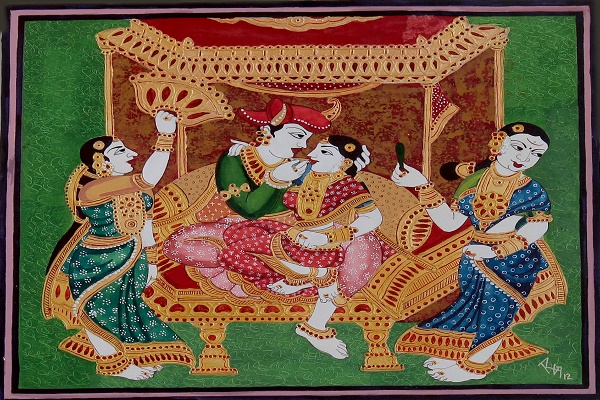
Within every stroke of a brush lies a universe of emotion and expression. With hues that whisper stories and shades that shout dreams, the world of painting is a vibrant kaleidoscope of creativity and tradition. As Pablo Picasso once remarked, "Colors, like features, follow the changes of the emotions." But as art evolves, so do the means of expression. In the contemporary art sphere, the clash of traditional techniques against the bold versatility of acrylic paintings creates a symphony of contrasts that captivates both creators and connoisseurs.
Defining Traditional Painting Styles
Traditional painting is a rich and enduring form of artistic expression woven into the tapestry of human history. From the intricate beauty of Chinese watercolor painting to the mesmerizing realism of Renaissance oil paintings, traditional art captivates us with its timeless charm.
Traditional painting, at its core, refers to creating artworks using established techniques, styles, and materials passed down through generations. These time-honored methods often involve the use of brushes, canvases, and pigments like watercolors, oils, and tempera. The hallmark of traditional art lies in its commitment to preserving artistic heritage and embracing established conventions.
Historical Background
To gain a profound appreciation for traditional painting, one must embark on a historical voyage, delving into its origins and evolution. These traditional art styles are as varied as the cultures that gave birth to them.
In ancient China, for instance, traditional ink painting, known as "Sumi-e," dates back over a thousand years. This style emphasizes brushwork, simplicity, and the mastery of black ink to create landscapes and poetic expressions.
Meanwhile, the European Renaissance era saw the emergence of oil painting, famously championed by artists like Leonardo da Vinci and Rembrandt. Their oil-based pigments revolutionized the art world, enabling astonishing depth and realism.
Characteristics
Traditional painting is characterized by several key features and techniques that distinguish it from other art forms:
1. Realism
Many traditional styles prioritize a realistic representation of their subject matter. Whether it's the fine details in a Dutch still life or the ethereal landscapes of Chinese brush painting, the aim is to capture the essence of reality.
2. Brushwork
The stroke of the brush is central to traditional art. Various types of brushes and techniques, including stippling, hatching, and cross-hatching, work together to craft texture and depth in the artwork.
3. Layering
Traditional artists often employ a layering technique, applying multiple coats of paint to achieve the desired color and texture. This approach allows for subtle blending and intricate detailing.
4. Use of Classic Materials
Traditional painting leans on classic materials like canvas, wood, and pigments. These materials have stood the test of time, ensuring the longevity of the artwork.

Understanding Acrylic Painting
Acrylic art, a dynamic and versatile medium, has overtaken the art world. But what exactly is acrylic painting? In the simplest terms, it's a technique that employs acrylic paints, known for their fast-drying properties. These paints consist of pigments suspended in an acrylic polymer emulsion, creating a water-soluble yet quick-drying composition. It means that artists can apply multiple layers in a single session, blending and experimenting with colors to their heart's content. Unlike oil painting, which can take days or weeks to dry, acrylics offer immediacy, allowing artists to work more spontaneously and expressively.
Emergence and Popularity
The ascent of acrylic painting as a significant art form marks a transformative moment in the art world. It debuted on the creative stage during the mid-20th century and quickly captured the hearts of artists for many compelling reasons. First and foremost, its fast drying time marked a departure from the often lengthy process associated with oil painting. This immediate drying time allowed artists to work more quickly, facilitating experimentation and innovation. Moreover, the versatility of acrylics on various surfaces, from canvas to wood and even unconventional materials like metal and glass, expanded the horizons of artistic possibilities. As a result, acrylic art found a firm footing in the art world, captivating artists with its accessibility and endless potential.
Characteristics
What sets acrylic art apart is its distinctive characteristics
-
Versatility
One of the standout features of acrylic paintings is its remarkable versatility. Acrylics can be used to create various effects, from translucent glazes to thick impasto textures. The range of application methods, including brushes, palette knives, and even pouring, opens the door to a world of artistic experimentation.
-
Vibrancy
The vibrancy of acrylic colors is another hallmark. The pigments are vivid and long-lasting, ensuring your artwork maintains its brilliance over time.
-
Compatibility
Acrylics are known for their compatibility with a wide array of mediums, enabling artists to explore mixed-media approaches for added depth and dimension. Whether you aim to achieve a watercolor-like delicacy or a bold, textured masterpiece, acrylics offer a spectrum of possibilities.
Comparing and Contrasting: Traditional vs. Acrylic Painting Styles
Art is a symphony of colors and techniques, an evolving canvas artists use to communicate their emotions and visions. In the world of painting, two prominent styles have etched their mark—traditional and acrylic. Let's dive into the intriguing realm of artistry and contrast these styles in four pivotal aspects.
Color Vibrancy
When it comes to color vibrancy, traditional and acrylic paintings stand on different ends of the spectrum. Traditional paintings, rooted in age-old techniques, often exude a timeless, subdued charm. The colors in these artworks tend to be more muted and possess a gentler, almost ethereal quality. Think of classical oil paintings with their soft, blended hues and the use of earthy pigments.
In contrast, acrylic art is celebrated for its vivid and intense color palette. Acrylic paints are known for their vibrancy and the ability to maintain brilliance over time. Artists revel in the acrylic medium's capacity to create sharp, striking contrasts and rich, expressive colors. The innate ability of acrylics to provide a bolder and more contemporary color experience sets them apart in color vibrancy.
Techniques
Technique, the heart of any masterpiece, is where traditional and acrylic painting styles diverge. Traditional painting techniques have been honed and perfected over centuries, with artists meticulously layering paints to create depth and texture. Utilizing oil-based paints in traditional art techniques allows artists to achieve a meticulous blending of colors, facilitating the creation of gentle transitions and lifelike intricacies.
In contrast, acrylics provide an entirely distinct array of techniques. Due to their fast-drying nature, acrylic paints encourage a more spontaneous and flexible approach. Artists can layer acrylics quickly, enabling experimentation with impasto, glazing, and a wide array of texture techniques. The acrylic medium encourages an adventurous and bold approach, promoting the creation of highly textured and expressive artworks.
Flexibility
Flexibility is where acrylics truly shine. Acrylic paints dry quickly, allowing artists to work rapidly and revise their compositions. The versatility of acrylics complements modern, high-paced artistic approaches, allowing artists to react promptly to their creative inspirations. Acrylic paints can be applied to a wide range of surfaces, including canvas, paper, and wood, which enhances their remarkable adaptability.
In contrast, traditional painting methods, often oil-based, require patience and a more structured approach. The extended drying times can limit artists looking to explore dynamic, layered compositions. The rigidity of traditional techniques, while producing remarkable results, can hinder acrylics' spontaneity.
Subject Matter
The choice of subject matter in traditional and acrylic art is intrinsically tied to their characteristics. With their refined and time-honored techniques, traditional painting styles tend to lean toward classical subjects and portraiture. They often depict historical scenes, religious imagery, and realistic portrayals of the human form.
On the other hand, acrylic paintings frequently embrace a contemporary and experimental approach to subject matter. Acrylic artists are known for their willingness to push boundaries and explore a wide range of topics. Abstract and non-representational themes are common in acrylic art, allowing for a broader range of subject matter choices, from modern urban landscapes to abstract interpretations of emotion.
In essence, the choice of traditional or acrylic art styles significantly influences the subject matter, with tradition embracing classic themes and acrylics fostering innovation and diversity.

Read More: Traditional Paintings Depicting the Mystical Aura of Lord Shiva
Wrapping Up
Summarizing the exploration of traditional and acrylic painting styles, we've unveiled a world rich in color and technique. The clash of tradition and innovation within the art sphere has produced a dynamic juxtaposition that enthralls both creators and appreciators.
The need for these two contrasting styles, with their unique attributes, lies in the broad spectrum of artistic expression they offer. Traditional painting keeps the flame of timeless techniques and classic subjects alive, connecting us to our cultural heritage. In contrast, acrylics give the modern artist a canvas of boundless possibilities, fostering innovation and pushing the boundaries of creativity.
At Indian Art Ideas, we support and inspire artists, whether they choose the traditional path or embark on an acrylic adventure. Our portfolio is designed to cater to the diverse needs of the art community. Explore our offerings today.






















